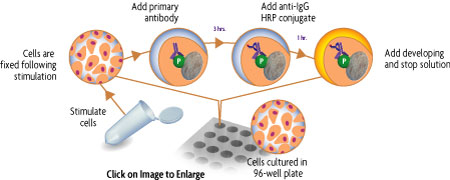THIS PRODUCT IS DISCONTINUED
Fast Activated Cell-based ELISA (FACE™) Kits provide a simple, sensitive method for detecting protein phosphorylation directly in the cell, without making extracts or performing electrophoresis and membrane blotting. These 96-well, high-throughput assays are available in both colorimetric and chemiluminescent formats for over 20 different targets (see list at right). For complete details, click the FACE™ Method tab below.
Each FACE c-Jun Kit provides 96 rxns each of 2 antibodies that enable you to monitor and compare the levels of both phosphorylated and total c-Jun. The S63 kit contains phospho-c-Jun antibody that recognizes c-Jun only when phosphorylated at Ser63; it does not recognize the phosphorylated forms of JunD or JunB. The S73 kit contains phospho-c-Jun antibody that recognizes c-Jun when phosphorylated at Ser73, but it also recognizes JunD when phosphorylated at Ser100. Both kits contain a total-c-Jun antibody that recognizes c-Jun regardless of the phosphorylation state. Click the c-Jun Info tab below for data and more information.
| Name | Format | Cat No. | Price | |
|---|---|---|---|---|
| FACE™ c-Jun (S63) | 1 x 96 rxns | 48125 | Discontinued | |
| 5 x 96 rxns | 48625 | Discontinued | ||
| FACE™ c-Jun (S63) Chemi | 1 x 96 rxns | 48225 | Discontinued | |
| 5 x 96 rxns | 48725 | Discontinued | ||
| FACE™ c-Jun (S73) | 1 x 96 rxns | 48135 | Discontinued | |
| 5 x 96 rxns | 48635 | Discontinued | ||
| FACE™ c-Jun (S73) Chemi | 1 x 96 rxns | 48235 | Discontinued | |
| 5 x 96 rxns | 48735 | Discontinued | ||
| FACE™ c-Jun Manual |
| FACE™ Profile |
| Cell Biology Products Brochure |
| IsoCyte™ Application Note – Phospho-Protein Detection |
| MSDS: Sodium Azide |
| MSDS: Sulphuric Acid |
| MSDS: Thimersol |

Figure 1: Measurement of phosphorylated and total c-Jun.NIH/3T3 cells were cultured in 96-well plates and serum-starved for 16 hours. Cells were then treated with 25 µg/ml of anisomycin for 30 minutes and fixed. Total and phospho c-Jun were each assayed in triplicate using either the phospho-c-Jun (S63), phospho-c-Jun (S73) or total c-Jun antibodies included in the FACE c-Jun Kit. Data was plotted after correction for cell number (performed through use of Crystal Violet).
Antibody Specificities
The phospho-c-Jun (S63) antibody is specific for phosphorylated c-Jun (S63) and was raised against a synthetic phospho-peptide corresponding to residues surrounding Serine 63 of human c-Jun. This antibody recognizes c-Jun when phosphorylated at this site and does not recognize the phosphorylated forms of JunD or JunB. The phospho-c-Jun (S73) antibody is specific for phosphorylated c-Jun (S73) and was raised against a synthetic phospho-peptide corresponding to residues surrounding Serine 73 of human c-Jun. This antibody recognizes c-Jun only when phosphorylated at this site and also recognizes JunD when phosphorylated at Serine 100. The total-c-Jun antibody recognizes c-Jun proteins regardless of the phosphorylation state. Each antibody is provided in a quantity sufficient for one 96-well assay.
c-Jun Overview
c-Jun is a component of the transcription factor AP-1, which binds and activates transcription at TRE/AP-1 elements. The c-Jun oncogene encodes a nuclear protein, p39, that interacts with the AP-1 c-Fos oncogene product and forms a transacting heterodimer. c-Jun plays an important role in the regulation of gene expression and signal transduction processes and is also suggested to be actively involved in the differentiation of B-chronic lymphocytic leukemia cells and Hodgkin’s Reed-Sternberg cells as well as in the malignant transformation of melanocytes, which makes it a promising drug target.
The FACE™ Method
In FACE, cells are cultured in 96-well plates and stimulated to induce the pathway of interest. Following stimulation, the cells are fixed rapidly, which preserves activation-specific protein modifications. Each well is then incubated with a primary antibody specific for the activated protein of interest. Subsequent incubation with secondary HRP-conjugated antibody and developing solution provides a colorimetric or chemiluminescent readout that is quantitative and reproducible (Figure 1). The number of cells in each well can be normalized easily with the provided Crystal Violet solution. FACE Kits also contain primary antibody specific for the native inactive protein, so you can monitor both native and activated protein levels in the same experiment. FACE eliminates cellular extractions, radioactive kinase assays, time-consuming Westerns and inefficient epitope interactions that occur on membranes. FACE is a highly sensitive high-throughput assay designed for detecting activated proteins within mammalian cells.
Figure 1: Flow chart of the FACE process.
Flow chart of the FACE in cell Western method that uses a cell based ELISA to measure the levels of the native and phospho forms of signaling proteins and kinases that are activated by phosphorylation.
Contents & Storage
Two (or ten) 96-well plates for culturing cells, 96 (or 5 x 96) rxns each of two primary antibodies (1 phospho-specific, 1 specific for native protein), HRP-conjugated secondary antibody, Quenching Solution, 1X Antibody Blocking Buffer, 1X Antibody Dilution Buffer, 10X PBS, 10% Triton X-100, 1% SDS Solution, Developing and Stop Solutions, and Crystal Violet Cell Quantification Solution. Storage conditions vary from room temperature to -20°C, see manual for details. All reagents are guaranteed stable for 6 months when stored properly.


